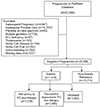The impact of response to iron therapy on maternal and neonatal outcomes among pregnant women with anemia
- PMID: 35033748
- PMCID: PMC10446247
- DOI: 10.1016/j.ajogmf.2022.100569
The impact of response to iron therapy on maternal and neonatal outcomes among pregnant women with anemia
Abstract
Background: Anemia during pregnancy is associated with increased risks of preterm birth, preeclampsia, cesarean delivery, and maternal morbidity. The most prevalent modifiable cause of pregnancy-associated anemia is iron deficiency. However, it is still unclear whether iron therapy can reduce the risks of adverse outcomes in women with anemia.
Objective: This study aimed to determine whether response to iron therapy among women with anemia is associated with a change in odds of adverse maternal and neonatal outcomes.
Study design: This was a population-based cohort study (2011-2019) using an institutional database composed of obstetrical patients from 2 delivery hospitals. Patients with adequate prenatal care were classified as being anemic or nonanemic (reference). Patients with anemia were further stratified by success or failure of treatment with oral iron therapy using the American College of Obstetricians and Gynecologists criteria for anemia at the time of admission for delivery: successfully treated (Hgb≥11 g/dL) or unsuccessfully treated ("refractory;" Hgb<11 g/dL). All categories of women with anemia categories were compared with the reference group of women without anemia using chi-square and logistic regression analyses. The primary outcomes were preterm birth and preeclampsia.
Results: Among the 20,690 women observed, 7416 (35.8%) were anemic. Among women with anemia, 1319 (17.8%) were refractory to iron therapy, 2695 (36.3%) had a successful response to therapy, and 3402 (45.9%) were untreated. Successfully treated patients with anemia had a significant reduction in the odds of preterm birth (5.1% vs 8.3%; adjusted odds ratio, 0.59; 95% confidence interval, 0.47-0.72) and preeclampsia (5.9% vs 8.3%; adjusted odds ratio, 0.75; 95% confidence interval, 0.61-0.91). Refractory and untreated patients had significantly increased odds of preterm birth (adjusted odds ratio, 1.44 [95% confidence interval, 1.16-1.76] and 1.45 [95% confidence interval, 1.26-1.67], respectively) and preeclampsia (adjusted odds ratio, 1.54 [95% confidence interval, 1.24-1.89] and 1.44 [95% confidence interval, 1.25-1.67], respectively). All groups of women with anemia had increased odds of postpartum hemorrhage and decreased odds of delivering a small for gestational age neonate. There was no difference in composite neonatal morbidity.
Conclusion: Successful treatment of anemia with oral iron therapy was associated with a reduction in the odds of preterm birth and preeclampsia. Women with refractory anemia had similar outcomes to those who were untreated, emphasizing the importance of monitoring response to iron therapy during pregnancy.
Keywords: iron deficiency anemia; maternal morbidity; neonatal morbidity; preeclampsia prevention; preterm birth prevention.
Copyright © 2022 The Author(s). Published by Elsevier Inc. All rights reserved.
Conflict of interest statement
The authors report no conflict of interest.
Figures



References
-
- Stevens GA, Finucane MM, De-Regil LM, et al. Global, regional, and national trends in haemoglobin concentration and prevalence of total and severe anaemia in children and pregnant and non-pregnant women for 1995–2011: a systematic analysis of population-representative data. Lancet Glob Health 2013;1:e16–25. - PMC - PubMed
-
- Beckert RH, Baer RJ, Anderson JG, Jelliffe-Pawlowski LL, Rogers EE. Maternal anemia and pregnancy outcomes: a population-based study. J Perinatol 2019;39:911–9. - PubMed
-
- World Health Organization. Prevalence of anaemia in pregnant women (aged 15201349) (%). 2021. Available at: https://www.who.int/data/gho/data/indicators/indicator-details/GHO/preva.... Accessed December 6, 2021.
-
- American College of Obstetricians and Gynecologists. ACOG Practice Bulletin No. 95: anemia in pregnancy. Obstet Gynecol 2008;112:201–7. - PubMed
Publication types
MeSH terms
Substances
Grants and funding
LinkOut - more resources
Full Text Sources
Medical

